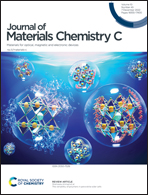Water-soluble Cit-NaYbF4:Tm3+ with enhanced 802 nm emission by Sr2+ ion doping for in vivo fluorescence molecular tomography†
Abstract
As a new type of optical imaging, fluorescence molecular tomography (FMT) has great potential in the field of biomedicine. However, current fluorescent probes still have some limitations that make in vivo FMT imaging quite challenging. In this study, Cit-NaYb0.98−xF4:2%Tm3+/x%Sr2+ upconversion nanoparticles (UCNPs) were successfully prepared by a one-step hydrothermal method, which overcomes the shortcomings of most organic small molecular fluorescent dyes. Importantly, Sr2+ doping can not only significantly reduce the radius of NaYbF4 but also considerably enhance the 800 ± 10 nm emission by about 35.5 times. CCK-8 assay and confocal laser scanning microscopy images (CLSM) also showed that the toxicity of NaYb0.93F4:2%Tm3+/5%Sr2+ to HeLa cells was decreased due to size reduction. In vitro and in vivo experiments showed that the UCNPs have excellent FMT imaging quality. After using the Compressive Sampling Matching Pursuit (CoSaMP) algorithm for 3D reconstruction, the location error of the fluorophore center was small, and the reconstructed target shape was close to that of the real light source. The reconstruction results further proved the feasibility and efficiency of Cit-NaYbF4:2%Tm3+/x%Sr2+ UCNPs for in vivo FMT imaging. This kind of UCNPs has been applied to FMT imaging and 3D reconstruction in vivo for the first time, promoting the development of FMT technology.



 Please wait while we load your content...
Please wait while we load your content...